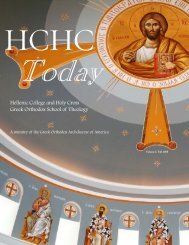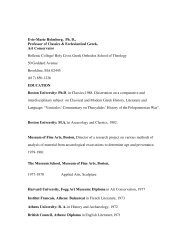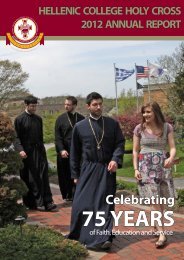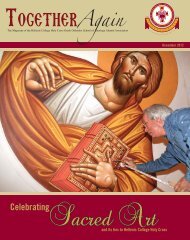GREEK, ROMAN AND BYZANTINE OBJECTS ... - Hellenic College
GREEK, ROMAN AND BYZANTINE OBJECTS ... - Hellenic College
GREEK, ROMAN AND BYZANTINE OBJECTS ... - Hellenic College
You also want an ePaper? Increase the reach of your titles
YUMPU automatically turns print PDFs into web optimized ePapers that Google loves.
8<br />
3. Greek, Roman and Byzantine Coins<br />
Coins were first introduced for commercial and trade purposes. The coin was a<br />
valuable, durable, mobile object which also made it an ideal vehicle for the<br />
dissemination of political messages, a function that it has preserved to the<br />
present day.<br />
3.I Greek Coin<br />
Surveys of the history of coinage begin with the introduction of coins into the<br />
ancient Greek world some time around 700 BC on the island of Aegina, or<br />
according to others, in 650 BC in Ephesus of Lydia, presumably because trading<br />
networks required an easier and lighter mode of exchange than the previous<br />
barter system in kind. As with most types of Greek art, we can distinguish three<br />
periods in the production and design of coins: the Archaic (ca. 700 - 480 BC); the<br />
Classical (ca. 480-330 BC) and the Hellenistic (ca. 330 BC to the Roman conquest<br />
of the Greek world in the first century). The coins produced by Greek cities<br />
under Roman rule are known as Roman provincial coins or Greek imperial coins.<br />
The first coins were made of electrum, a gold-silver alloy. Later,<br />
technological advances made the production of pure gold or pure silver coins<br />
alongside bronze and copper alloy coins. Coins were hand-made and not<br />
machine-produced as in the modern period. The central denomination of the<br />
ancient Greek world was the drachm(a), which translated literally means 'a<br />
handful.' The drachm was divided into six obols (lit., 'spit of iron') and the obol<br />
was further divided into the tetartemorion (1/4 of an obol and 1/24 of a drachm) and<br />
multiple divisions of it. Other common denominations were multiples of the<br />
drachm, such as the silver stater or didrachm (two drachmae), the tetradrachm (four<br />
drachmae) and, particularly in Syracuse, the large silver decadrachm (ten drachmae).<br />
Several hundred of the approximately 1500 self-governing city-states<br />
(poleis) issued their own coins although only a few circulated widely beyond<br />
their city-state, such as the silver staters of Aegina and Athens; the Athenian<br />
tetradrachm (4.3 grams of silver to a drachm) eventually became the primary<br />
trading coin throughout the classical period and set the standard for the coin<br />
issues of other city-states.<br />
The main design features of ancient coins were portraits of the city-state's<br />
patron god or goddess or those of a legendary hero on the one side of the coins<br />
and symbols of the city-state on the other (e.g., turtle and later tortoise for<br />
Aegina; the owl of Athena for Athens; the head of the nymph Arethusa and a<br />
victorious quadriga for Syracuse). The inscriptions usually were the name of the<br />
issuing city-state. The peak of technical quality and aesthetic detail was reached

















